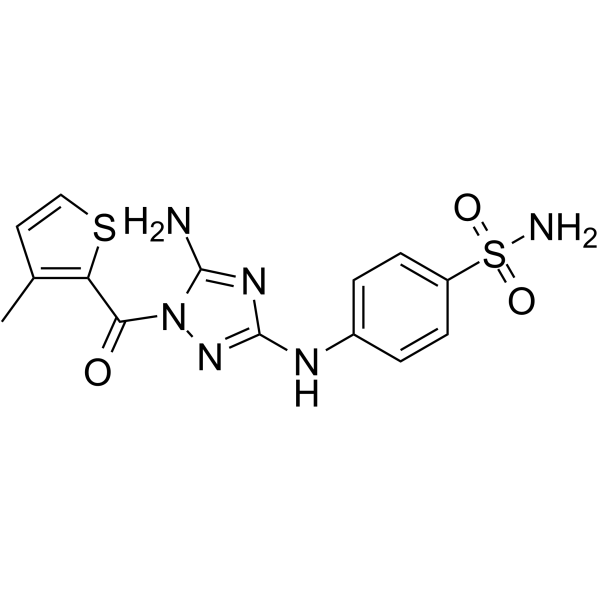443798-09-2
| Name | 3-Methylthienyl-carbonyl-JNJ-7706621 |
|---|
| Description | 3-Methylthienyl-carbonyl-JNJ-7706621 is a potent and selective inhibitor of cyclin-dependent kinase (CDK), with IC50s of 6.4 nM and 2 nM for CDK1/cyclin B and CDK2/cyclin A, respectively. 3-Methylthienyl-carbonyl-JNJ-7706621 also shows potent inhibition of GSK-3 (IC50=0.041 μM) and modest potency against CDK4, VEGF-R2, and FGF-R2 (IC50=0.11, 0.13, 0.22 μM, respectively). 3-Methylthienyl-carbonyl-JNJ-7706621 can be used for the research of cancer[1]. |
|---|---|
| Related Catalog | |
| Target |
CDK2/cyclinA:2 nM (IC50) CDK1/cyclinB:6.4 nM (IC50) CDK4:0.11 μM (IC50) FGFR2:0.22 μM (IC50) VEGFR2:0.13 μM (IC50) GSK3:41 nM (IC50) |
| In Vitro | 3-Methylthienyl-carbonyl-JNJ-7706621 shows potent potency against GSK-3 (IC50=0.041 μM) and modest potency against CDK4, VEGF-R2, and FGF-R2 (IC50=0.11, 0.13, 0.22 μM, respectively)[1]. 3-Methylthienyl-carbonyl-JNJ-7706621 inhibits cell proliferation, with IC50s of 0.28 μM, 0.25 μM, 0.45 μM, 0.75 μM, 0.59 μM and 0.12 μM for HeLa, HCT-116, A375, SK-OV-3, MDA-MB-231 and PC-3 cells, respectively[1]. |
| In Vivo | 3-Methylthienyl-carbonyl-JNJ-7706621 (75-125 mg/kg; i.p. once daily for 32 days) inhibits the A375 human melanoma tumor growth and prolongs the survival in nude mice[1]. 3-Methylthienyl-carbonyl-JNJ-7706621 exhibits oral bioavailability (nude mouse 2%, rat 8%, dog 63.3%), terminal elimination half-lives (nude mouse 1.70, rat 2.20 and, dog 2.36 h) and Cmax (nude mouse 0.21, rat 2.5, dog 4.58 μM) following oral administration (nude mouse 30, rat 30 , dog 10 mg/kg)[1]. 3-Methylthienyl-carbonyl-JNJ-7706621 exhibits terminal elimination half-lives (nude mouse 0.51, rat 0.64 and, dog 3.89 h), Cmax (nude mouse 6.4, rat 23.2, dog 2.19 μM) and AUC (nude mouse 3.2, rat 11.4, dog 2.45 μM•h) following intravenous administration (nude mouse 3, rat 3 and, dog 1 mg/kg)[1]. Animal Model: Male athymic mice were implanted with A375 human melanoma cells[1] Dosage: 75, 100, 125 mg/kg Administration: I.p. once daily for 32 days Result: Reduced the tumor growth. Survival was increased by about 3 weeks compared with vector alone. |
| References |
| Molecular Formula | C14H14N6O3S2 |
|---|---|
| Molecular Weight | 378.43 |
